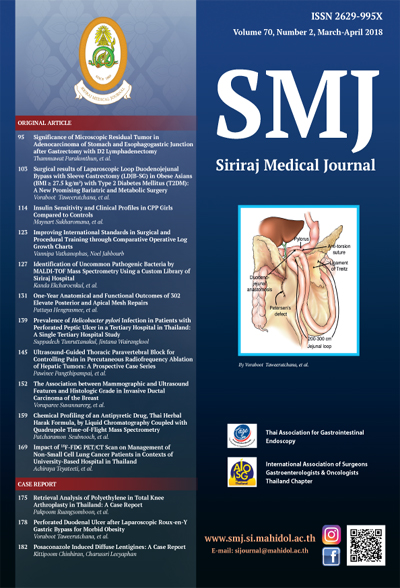Ultrasound-Guided Thoracic Paravertebral Block for Controlling Pain in Percutaneous Radiofrequency Ablation of Hepatic Tumors: A Prospective Case Series
Abstract
Objective: Patients with hepatic tumors undergo percutaneous radiofrequency ablation (PRFA) performed under local anesthesia and intravenous sedation can experienced severe post procedural pain. This prospective case series
evaluated the feasibility, efficacy and safety of ultrasound assisted thoracic paravertebral blocks (TPVB) at three levels (T5-6, T7-8 and T9-10) for post procedural pain control.
Methods: 35 patients with hepatic tumors received 3 levels ultrasound guided right thoracic paravertebral blocks (TPVB) at T5-6, T7-8 and T9-10. Patients were administered with propofol bolus with continuous infusion for
sedation. Pain score at post anesthesia care unit and maximum pain score during 24 hours were recorded.
Results: All patients except one reported minimal pain after PRFA. Mean NRS on arrival in PACU was 0.51 (SD:1.50; range: 0-7) at rest and 1.20 (SD: 1.95; range: 0-10) on movement. The maximum pain score during 24 hour
post-procedure period was 1.31 (SD: 1.93; range: 0-10). One case reported severe pain at shoulder due to the tumor adjacent to the diaphragm. Patients can tolerate TPVB well and there were no complications associated with the
blocks.
Conclusion: 3 levels ultrasound guided TPVB can produce the effective post procedural pain control. The technique is promising and may also be appropriate for other interventional radiological procedures such as trans-arterial
chemoembolization (TACE) of hepatic tumors and percutaneous trans-hepatic biliary drainage (PTBD).
Downloads
Published
How to Cite
Issue
Section
License
Authors who publish with this journal agree to the following conditions:
Copyright Transfer
In submitting a manuscript, the authors acknowledge that the work will become the copyrighted property of Siriraj Medical Journal upon publication.
License
Articles are licensed under a Creative Commons Attribution-NonCommercial-NoDerivatives 4.0 International License (CC BY-NC-ND 4.0). This license allows for the sharing of the work for non-commercial purposes with proper attribution to the authors and the journal. However, it does not permit modifications or the creation of derivative works.
Sharing and Access
Authors are encouraged to share their article on their personal or institutional websites and through other non-commercial platforms. Doing so can increase readership and citations.











